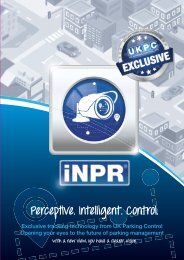Create successful ePaper yourself
Turn your PDF publications into a flip-book with our unique Google optimized e-Paper software.
<strong>iNPR</strong> Frequently Asked Questions<br />
Below we have answered some FAQ’s on Intelligent Number<br />
Plate Recognition and how the new technology works.<br />
Why was <strong>iNPR</strong> created?<br />
ANPR was a great solution for parking management,<br />
but has its limitations. <strong>iNPR</strong> was created with the<br />
aim to make car park management more customer<br />
focussed. Utilising cutting edge technology to help<br />
clients manage parking spaces more effi ciently.<br />
<strong>iNPR</strong> is an advanced parking management solution,<br />
providing customer only parking, can pinpoint<br />
unauthorised parking automatically and provides<br />
in depth car park data reporting. <strong>iNPR</strong> supersedes<br />
legacy ANPR technology.<br />
How does your <strong>iNPR</strong> technology differ to the<br />
current ANPR car park management solution?<br />
With ANPR, the driver of a vehicle only has to adhere<br />
to the published time duration limit of a car park.<br />
Legacy ANPR technology cannot detect if they are a<br />
genuine user and enter the intended facilities. <strong>iNPR</strong><br />
not only registers the vehicle registration and the entry/<br />
exit times, but it also records to review and check if<br />
the vehicles’ car passengers visit the store.<br />
Can you give an example of how <strong>iNPR</strong> works?<br />
Imagine a scenario where a vehicle parks in a car park<br />
owned by Supermarket A but then walks off-site to<br />
shop at Supermarket B before returning to their vehicle<br />
and leaving the site. As long as the vehicle doesn’t<br />
overstay the published time limits of the car park then<br />
current ANPR technology cannot help Supermarket A<br />
keep their car park spaces free for genuine customers,<br />
and cannot prevent the competitions’ customers from<br />
parking in their spaces. With <strong>iNPR</strong>, non-customer<br />
usage can be identifi ed in car parks.<br />
How can you prove that the customer has<br />
not visited or entered the facility?<br />
The <strong>iNPR</strong> system includes a video of the motorist from<br />
the time they park and leave their vehicle until they go<br />
directly off-site without visiting the facility. It also shows<br />
the same in reverse when the car leaves the car park.<br />
E.g. <strong>iNPR</strong> shows that the motorist has come from<br />
off-site directly before they get back into their vehicle<br />
and leave the car park.<br />
But what happens if they walk off-site for<br />
example, to get some money from a cash<br />
machine before visiting the facility?<br />
That’s exactly why our system checks where the<br />
motorist goes when they park their car and also where<br />
they have come from before re-entering the car and<br />
leave the car park. By checking both directions we<br />
can report if the motorist is a genuine user.<br />
So as long as the motorist enters the facility<br />
at some point they are deemed a ‘genuine user’<br />
but using your scenario from before, would<br />
‘Supermarket A’ be happy if their customers<br />
first shopped at ‘Supermarket B’ before<br />
entering their site?<br />
That would depend on the site’s policy. <strong>iNPR</strong><br />
technology can be tailored to the site owners<br />
requirements, whereby they can decide if they<br />
consider any time off-site is unacceptable.<br />
On most sites, we would recommend that as long<br />
as the motorist has entered the site’s facility then no<br />
parking charge notice should be issued, since we do<br />
not follow them after they have left the car park and<br />
cannot know their reason for being off-site.<br />
From a retail point of view, What if someone<br />
goes into the store but doesn’t make a purchase.<br />
If they don’t have a receipt wouldn’t they be<br />
deemed a non-customer?<br />
Lots of people like to browse before making a<br />
purchase at a later date. With <strong>iNPR</strong> technology we<br />
have created our technology to consider a customer<br />
to be someone who simply enters and then later<br />
leaves a store.<br />
16



